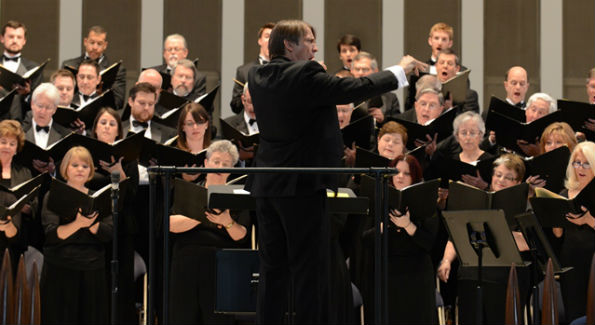REVIEW: Scott Tucker makes his mark with ambitious program.
By Patrick D. McCoy

The new-ish Artistic Director for the Choral Arts Society really added his own mark to the music program with the “Brass, Brahms and Britten” performance. (Photo by Russell Hirshorn)
The Choral Arts Society of Washington‘s performance of “Brass, Brahms and Britten,” was not Artistic Director Scott Tucker‘s first production with the society, but it marked a new era. Though Tucker has already conducted most of the concerts of the season, this installment represented his own stamp on programming. It was more of an experience, rather than a concert. There was a bustling of excitement in witnessing the new conductor take the stage in a moment created especially for him.
The arts community was well represented by the presence of former artistic director of 47 years Norman Scribner, Diana Saez with Coral Cantigas, Thomas Colohan of the Washington Masterchorale, Stanley Thurston from WPAS Men and Women of the Gospel and Heritage Signature Chorale, noted soloist Linda Maguire, Mark Ohnmacht representing the Washington Concert Opera and Wayne Brown of NEA.
After a gracious welcome by WETA’s Deb Lamberton, the new maestro entered down the long center aisle, took his place on the podium, and was greeted with a warm Washington welcome. The repertoire, for the most part, represented Choral Arts’ long appreciation of standard choral works, cultivated by Scribner. Ideally, the audience at a performance should be more than mere spectators, and Tucker did just that by inviting his audience on the journey from darkness to light, as depicted in the musical contrast of the program.
As an instinctive conductor, Tucker built his first concert on standard composers that have served the chorus well in the past and then introduced a few of his own.
The first choral offering on the program, “Apparebit repentina dies” for choir and brass by Paul Hindemith, was perhaps the only exception. Hindemith’s tonally vast work seemed to be a different style for the choir, and though it was a noble reading, the unfamiliarity came through.
The second group, devoted to music of Johannes Brahms, showed the listener the true depth of the ensemble’s sound. Brahms is a composer that has served Choral Arts well in the past – particularly his “German Requiem.” In “Warum ist das Licht gegeben Mühseligen,” Tucker drew expansive vocal lines surrounded by vocal warmth. The sopranos gave an elegant ascending arch to the sound, equally complimented by the creamy richness of the alto voices. The male voices of the choir were exceptional, especially the basses who anchored the ensemble in “Mit Fried und Freud.
” Concluding the set was the motet “Laß dich nur nichts dauren mit Trauren” from the “Geisliches Lied, Op. 30.” Accompanied by organist Julie Huang, the choir sang this work exquisitely. Each voice entered seamlessly in succession with a reverent urgency. The moving lines of the concluding ‘amen’ were like tears of angels calling out one to one for heaven’s mercy. Providing the big finish for the first half of the concert was the regal splendor of William Walton’s “Antiphon.
”
The second half of the concert began with Ralph Vaughan William’s festive “O Clap Your Hands” accompanied by full organ and brass. Huang was particularly superb, playing with great virtuosity and glittering facility. Culminating on the words “Sing praises,” the grandeur of the soaring voices punctuated by the organ summoned the elements of praise and exaltation. This was a marked contrast from the first element of the concert’s theme and it was gratifying to see Tucker’s thematic concept play out.
Britten’s “Rejoice in the Lamb” was a fantastic vehicle for both the choral voices and the organ. The work made great use of the acoustics of the National Presbyterian Church and created the tension that would ultimately build to the concert’s climax. For his first concert, it was unique that Tucker used soloists from within the ranks; in doing so, it revealed that the newly minted conductor not only values his own interests, but also the exposure and growth of his singers.
Recreating the antiphonal glories of Saint Mark’s Cathedral in Venice were two choral works by Giovanni Gabrieli. Much can be said about the precision and preparation of the chorus under Tucker’s direction. Each divided choir and section entered confidently at his gesture. The brass ensemble played from the chancel area with the exception of a lone trombone that played from the rear of the church. Surrounding the entire audience in multiple ensembles of voices offered the comtemplative “O Jesu, mi dulcissime” followed by the abounding splendor of the “Jubilate Deo.” As implied by the title, the chorus and brass swelled to a jubliant finale, ending Tucker’s first program on a very high note.
A post concert reception followed in Stone Hall at which Tucker gave a preview of the 2013-2014 season.
Check out our full profile of Maestro Tucker in the April 2013 Creative Issue.
Recently named among the Forty Under 40 for his contributions to arts and humanities, Patrick D. McCoy received a B.M. in vocal performance from Virginia State University and a M.M. in church music from the Shenandoah Conservatory in Winchester, Va. He has contributed arts and culture pieces to CBS Washington, The Afro-American Newspaper and the newly published book, “In Spite of the Drawbacks” (Association of Black Women Historians), which includes his chapter on legendary soprano Leontyne Price. McCoy has interviewed some of the most acclaimed artists of our time, including Renée Fleming, Denyce Graves, Norman Scribner, Julian Wachner, Joshua Bell, Christine Brewer and Lawrence Brownlee. Listen to these interviews and others at Blog Talk Radio. McCoy may be reached via email at wlperformingarts@aol.com and on Twitter @PatrickDMcCoy.
//
//
//




